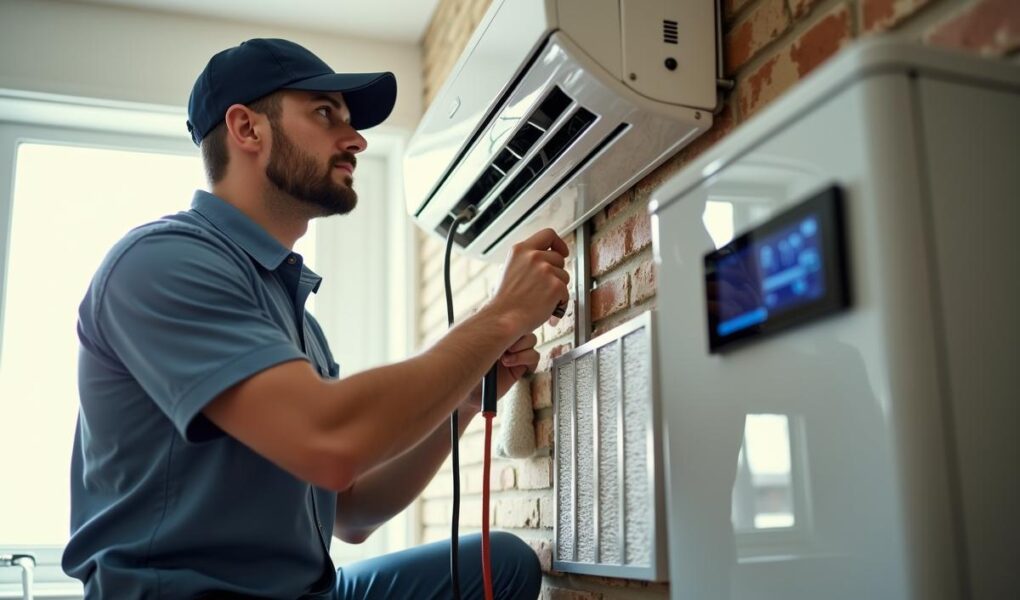To improve indoor air quality, start with proper air conditioning maintenance. People often overlook how significant these routine tasks are, focusing instead on temperature settings or convenient remote features. Yet, the simplest way to reduce airborne pollutants often begins with preserving your cooling system’s quality. By paying attention to the condition of your air conditioner, you’re already taking a step toward a fresher indoor atmosphere.
Why Regular HVAC Service Matters
Regular HVAC service keeps your cooling system running smoothly while saving you needless headaches. When performed consistently, these checkups are designed to improve performance, bolster system efficiency, and minimize the odds of inconvenient breakdowns. That means fewer emergency repairs and less stress about sudden temperature spikes when the summer heat becomes unrelenting.
Some people see this type of service as optional, but it can have real benefits for both your health and budget. A well-maintained unit promotes better air circulation, leading to air quality improvement while reducing energy bills. And by focusing on preventative maintenance, you’re extending the life of your system in a way that yields returns in the long run.
Key Steps for an AC Tune-Up
An AC tune-up targets specific components to achieve consistent cooling and enhanced reliability. It’s not just about lowering room temperature; it’s also about ensuring your system is in top shape for every day it runs. Paying attention to refrigerant levels, cleaning coils, and verifying that the system is working at its full potential are crucial parts of a tune-up.
Checking Refrigerant Levels and Coils
Refrigerant levels must remain balanced to maintain your AC unit’s performance optimization. When there’s too little refrigerant, the system strains to cool your space, driving up energy costs. Too much refrigerant can also create problems, so it’s a balancing act best handled by professionals during an HVAC servicing appointment. They’ll confirm the pressures and temperature differentials, ensuring everything is within the manufacturer’s specifications.
Along with monitoring refrigerant levels, coil cleaning is essential in protecting your air conditioner from dust accumulation. If the coils get overloaded with grime, your AC works harder to distribute cool air, affecting its longevity and energy savings. Frequent coil cleaning loosens stuck debris, allowing your cooling system upkeep practices to pay off significantly with a more efficient unit.
Air Filter Replacement for Better Airflow
Neglecting air filter replacement clogs the circulation pathway, forcing the AC to consume more power. Changing filters regularly gives your home a cleaner, fresher atmosphere and lowers the strain on your unit. Fresh filters stop dust from collecting in the vents, leading to noise reduction because the unit doesn’t have to push as hard to cool the space.
Replacing filters is often considered one of the easiest forms of air conditioner cleaning. Whether you choose a basic disposable filter or a high-efficiency alternative, the key is to keep the airflow unobstructed. This simple step keeps the air free from large particles and cuts down on the need for emergency repairs by preventing dust-related damage in the first place.
Seasonal Maintenance and Cooling System Inspection
Seasonal maintenance remains critical for preserving your AC’s overall health. In spring, you prepare your home for warmer days by conducting a cooling system inspection. In autumn, you safeguard the system against long idle periods and potential moisture buildup. Checking for leaks, fine-tuning settings, and ensuring the system is sealed tight can ward off many unwanted surprises.
Prioritizing Compressor Check
A compressor check is vital for transforming warm outdoor air into a refreshing indoor climate. Without a fully functioning compressor, no amount of filter replacement or coil cleaning can keep your home comfortable in scorching weather. Technicians often do a climate control inspection that includes a thorough look at how the compressor is handling refrigerant. This step detects any early signs of trouble before they magnify into bigger, costlier issues.
Thermostat Calibration for Energy Savings
While we often blame the AC itself for inconsistent temperatures, the thermostat can be the real culprit. Thermostat calibration can make a world of difference in how effectively your home cools and how much energy the system uses. A slight error in temperature sensing can cause prolonged run times or frequent stops and starts. By dialing in the proper calibration, you reduce both energy waste and monthly energy bills.
A calibrated thermostat also works in tandem with the entire HVAC system, leading to smoother operation overall. During a routine HVAC system maintenance session, technicians will confirm that the thermostat is reading temperatures accurately. Their adjustments could prevent system overuse and keep you from facing early wear and tear problems.
Ventilation Inspection and Duct Cleaning
Ventilation inspection is about more than just the air within the machine; it evaluates how air travels through your home. Leaky or obstructed ducts can funnel dust back into living spaces, undermining the quality of your indoor environment. By integrating duct cleaning into your regular plan, you remove blockages that force the AC to strain, boosting performance and saving money on utility bills.
Quiet Operation and System Longevity
Duct cleaning, along with ventilation maintenance, often brings about noise reduction. Air can move more freely without banging against clogged pathways, so you’ll hear a more consistent hum rather than rattling or whistling. Meanwhile, a well-maintained system lasts longer because it doesn’t have to fight against debris to move cool air, which further increases system longevity.
Balancing System Efficiency and Performance
One hallmark of a good cooling system is seamless performance under different weather conditions. Achieving that requires routine checkups that go beyond changing filters and looking at coil cleanliness. Whether it’s verifying refrigerant check results or adjusting tension on belts and motors, each little tweak gives you a bump in efficiency. As a result, you can cool your space swiftly without driving up power usage unnecessarily.
Sometimes, system upgrades also contribute to lower electricity costs. For instance, installing a more advanced thermostat or upgrading an older air conditioner can slash monthly bills while improving indoor air quality. Given that older units often operate less effectively, these upgrades can help you achieve real energy efficiency audit benefits without constant wear and tear on outdated components.
Avoiding Emergency Repairs and Extending System Lifespan
If you’ve ever experienced an AC breakdown on a scorching day, you know how frustrating it can be. By integrating seasonal AC check-up appointments into your plan, you minimize last-minute surprises. Technicians can catch issues like small refrigerant leaks or aging parts before they spiral out of control. This proactive approach saves you the stress and cost of trying to find emergency repairs when everyone’s AC is failing at the same time.
Steady, planned servicing also extends your system’s lifespan, ensuring you get maximum value for your money. A unit that receives consistent preventive HVAC care rarely experiences the abrupt failures common to neglected systems. Instead, it ages more gracefully, allowing you to decide on replacements or major fixes on your own terms rather than being forced into them at inconvenient times.
Looking Ahead with Performance Optimization
Optimizing performance isn’t a one-time event; it’s an ongoing partnership between you and your system. Fine-tuning components, aligning system settings, and documentation of each visit can transform occasional adjustments into long-term reliability. By focusing on each minor detail—such as condenser maintenance, thermostat calibration, and filter replacement—you forge a path toward better air quality and reduced utility bills.
When System Upgrades Are Worth It
Sometimes, consistent maintenance alone isn’t enough, especially if your unit is over a decade old or no longer up to modern standards. System upgrades, whether it’s a newer model or advanced features that improve airflow, offer a chance to drastically cut down on monthly bills. These improvements often enhance indoor air quality improvement by leveraging advanced filtration options. Over time, that equates to fewer visits from the AC repair technician and lower ongoing costs.
Keep Air Quality Front and Center
One benefit of regular cooling system upkeep is the noticeable boost to overall air quality. That can be especially valuable if you or family members deal with allergies or respiratory issues. A clean, well-serviced system traps dust, pollen, and other irritants, keeping them from floating around. Whether through effective Ventilation maintenance or continual coil inspections, the small efforts accumulate into a healthier indoor environment.
You’ll notice fewer odors and less stale air, especially when the system runs for extended periods. Any step you take, from periodic duct cleaning to careful refrigerant check, helps create a space where breathing is easier and daily life is more pleasant. The shift toward cleanliness becomes evident not just in how comfortably the AC cools, but also in how fresh each room feels.
A Steady Routine for Better Indoor Conditions
Cultivating a regular maintenance habit ensures your home becomes a haven from external environmental issues like humidity or pollution. Whether you’re doing a quick filter switch or scheduling a deeper air conditioner cleaning session, every action counts toward a smoother-running system. Even a small tweak like adjusting coolant pressures or calibrating the thermostat can save you money and reduce stress.
This routine helps you avoid dealing with bigger shocks to your wallet later on. Instead of encountering surprise failures, you gradually handle minor tasks that keep everything at peak performance. In the end, your AC runs reliably, your energy usage stays in check, and you minimize ongoing costs.
Final Thoughts
Maintaining a fresh and comfortable indoor atmosphere requires dedication to each aspect of the AC’s function. Investing time in regular checks, calibrations, and thorough inspections can make an immediate difference in your energy costs and the air you breathe. By staying proactive with essential tasks such as monitoring refrigerant levels, performing air filter replacement, and scheduling duct cleaning, you cultivate a system built for efficiency and longevity. Those small yet consistent efforts pay off—both in peace of mind and in the crisp, refreshing air that greets you every time you walk in.




